There are hundreds of possible chord progressions out there. Thankfully for the budding guitarist, many modern pop songs use just a few. This article presents five of the most common chord progressions, and learning them will allow you to play hundreds of songs. Note that the chord progressions will be presented in the key of C and in Roman numerals so that they can be easily transposed to other keys.
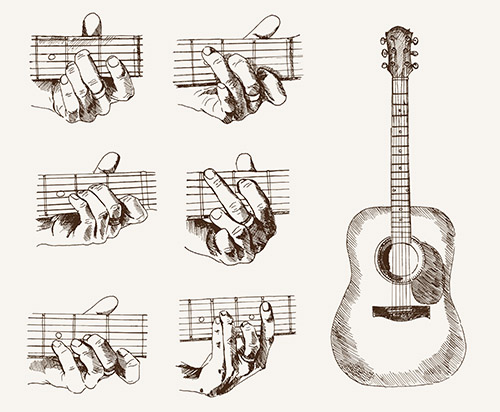
The Chord Progressions
1. C - G - Am - F (I - V -vi - IV)
This just might be the most popular chord progression in Western popular music. There is an actual mathematical explanation as to why it’s such a pleasant progression. The quick summary is that these four chords are opposites of each other. The V chord is the opposite of I, the vi is the opposite of V, and the IV is the opposite of vi. The contrast between them is what makes the progression sound so good.
Songs that use this progression include the verse of “Let It Be” by The Beatles, the entirety of “No Woman No Cry” by Bob Marley, the chorus of “Love Someone” by Justin Bieber, the verse and chorus of “Love Story” by Taylor Swift, the verse of “Don’t Stop Believing” by Journey, the verse of “Hey Soul Sister” by Train, the chorus of “Someone Like You” by Adele, and the list goes on and on. Watch our video on “Collide” by Howie Day and learn this popular progression!
2. C - F - G (I - IV - V)
Our second chord progression may be considered the foundation of classic rock ‘n’ roll, modern rock, and pop music. It is extremely common in songs from the 1960s to 1970s and traces its roots all the way back to the blues. Playing these three chords in different variations will also give you some other common progressions. A good example is the 12 bar blues which goes I - I - I - I - IV - IV - I - I - V - IV - I - V. Another example is I - IV - V - IV which allows us to play songs like “Louie Louie” by Richard Berry and “Wild Thing” by The Troggs. An example that uses the simple I - IV - V progression is the entirety of “Stir it Up” by Bob Marley. We cover how to play this chord progression for the verse of “Good Riddance” by Green Day. Take some time to play around with these three chords and you’ll be surprised by how many songs you can play by simply rearranging the order of the progression.
3. C - Am - F - G (I - vi - IV - V)
Also known as the 1950s progression because it was very popular in that decade, this chord progression is associated with the mainstream popularity of the doo-wop genre at the time. Popular songs that use this progression include the entirety of “Stand By Me” by Ben E. King, the verse of “Chain Gang” by Sam Cooke, and the verse of “Unchained Melody” made popular by The Righteous Brothers. Many modern pop songs also use the 50s progression, examples include the entirety of “Beautiful Girls” by Sean Kingston, the chorus of “What About Now” by Daughtry, and funnily enough, the entirety of “Friday” by Rebecca Black.
4. Am - F - C - G, vi - IV - I - V
Beginning with a minor chord, this progression tends to sound darker and sadder than the other four progressions. Examples of songs that use this progression include the entirety of “Cheap Thrills” by Sia, the chorus of “Africa” by Toto, the entirety of “Apologize” by OneRepublic, and the chorus of “Numb” by Linkin Park. Watch our video on “Zombie” by The Cranberries to learn this emotive progression.
5. C - F - Am - G, I - IV - vi - V
Our final progression is very similar to progression number 4, the only difference is the I and vi chords have switched places. What you’ll end up with is a similar sounding chord progression, just not as sad as the progression in number 4. Examples include the verse and chorus of “Say” by John Mayer, the entirety of “Magic” by B.O.B, the entirety of “Escape” by Enrique Iglesias, the verse and chorus of “Good Life” by One Republic, and the intro riff of “Hit Me With Your Best Shot” by Pat Benatar.
Many of these songs don’t just use the same four or five chords over the entire song. Most of the time, they’d use a combination of different chord progressions for the different sections of the song (verse, prechorus, chorus, etc.), but there’s a good chance that each of the sections uses one of the five common chord progressions.
How Many Chords Do I Have to Practice?
You may have noticed by now that all of these chord progressions really only use a different combination of four chords - the I, IV, V, and vi chords. This means that if you learn these four chords in the five most common guitar keys (C, A, G, E, D), you’ll be ready to play a huge number of songs.
My suggestion is to start with the key of G, as that’s the easiest key to play in, and then work your way through the keys of A, C, D, and finally, E.
Using the Capo to Change keys
Now, what if a song isn’t in one of the common guitar keys?
Well, that’s where your trusty capo will help you out. All you’ll need to do is pick the nearest common guitar key in relation to the key of the song, and then use the capo to move those chords up to get to your target key.
Take note that the capo can only move the key up and not down. So for example, if the song you’re trying to play is in the key of B major, you’d use your chords from the key of A instead of C (you can move A up to B, but you can’t move C down to B).
For a more in-depth study of how to use a capo, check out our video lesson and accompanying article.
Last Word
It really isn’t that difficult to learn how to play pop music on the guitar. As I’ve pointed out, pop songwriters don’t really use that many different chord progressions. With these five chord progressions, you’ll be able to play enough songs to last you a lifetime. These progressions also show up occasionally in other genres of music, so keep an ear out for them in your journey as an aspiring musician. Remember, start off with the key of G, then A, C, D, and E.
For those of you having trouble with playing the chord changes check out the chart below and this accompanying video!
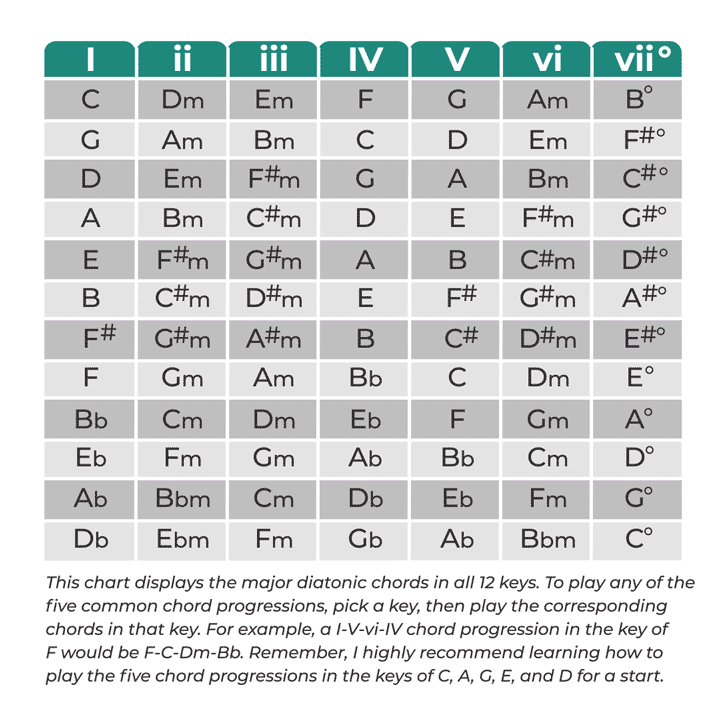
About the Author: Ze
Ze first began his journey playing original music and top 40s pop tunes around the country's popular venues. Eventually, through the music of John Mayer, he found a strong attraction to blues music. Ze has years of experience teaching beginners and intermediate guitarists. Currently with Liberty Park Music he is teaching Introduction to Guitar Playing for Complete Beginners, Rhythm Guitar to learn about strumming, chords and more, Guitar Essentials as a fast-track review course, and lots of Song Lessons on pop and rock hits.
Improve your guitar playing with more articles like this!
Free monthly guitar tips and advice delivered straight to your inbox!
Online Guitar Course from the same author
If you are looking to review your guitar basics like tuning, setup, reading TABS etc. with Ze, check out his Intro to Guitar Playing Course for Beginners.




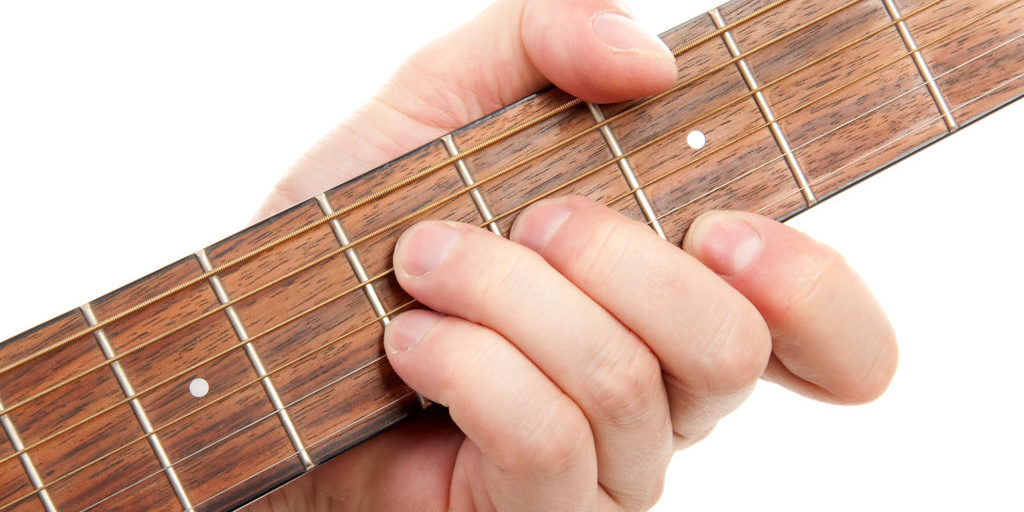
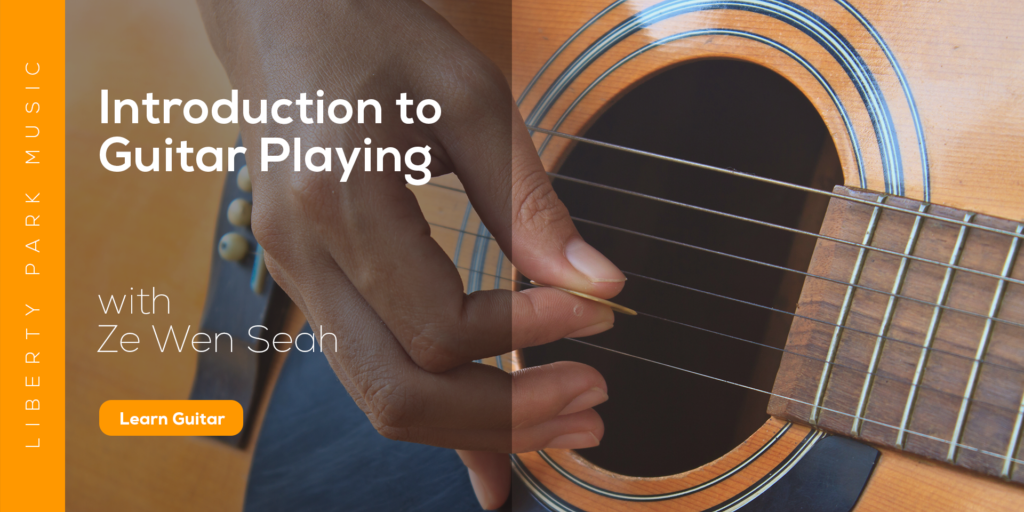
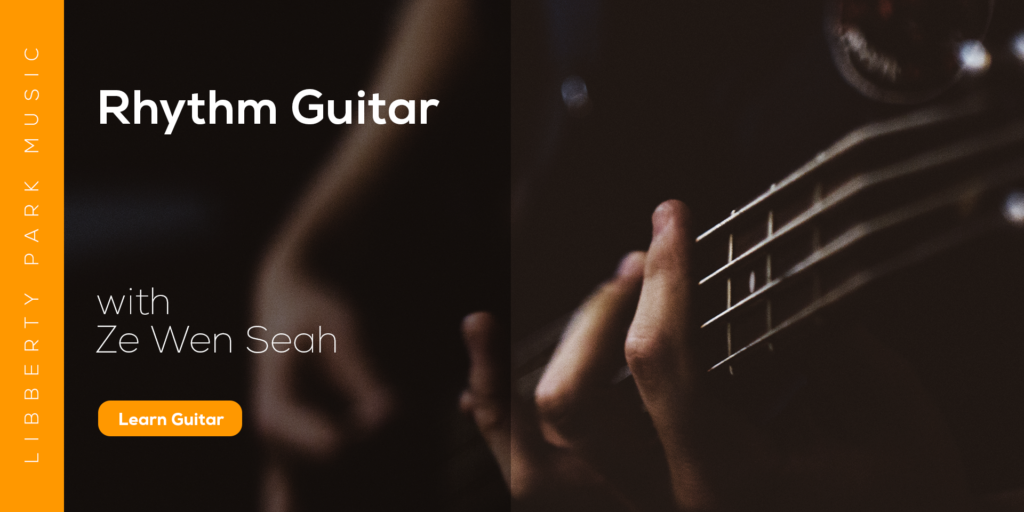
brilliant article!….many thanks for making it simple
Thanks Bruce. Let us know if you have any questions you’d like us to help answer, or areas you’d like to learn about. Leave a comment here, or email [email protected] and we will try to get back to you as soon as we can! Keep on learning buddy!
How would I know when to play a minor or a major chord in the chord progression?
Hi there. Thanks for the question. Whether to play a minor or major chord really depends on the key of the song. The chart at the end of the article shows what the 7 possible chords are in all 12 keys, so you can refer to that chart to determine whether a major or minor chord will be appropriate. Let me know if you want more clarification on this!
It’s amazing designed for me to have a website, which is beneficial
designed for my experience. thanks admin
Hi great article and video but don’t find it very clear which chord is played in the minor. For example, for the first progression above, I – V – VI -IV, shouldn’t this read I-V-vi – IV? You seem to do this in the table but not in the main text describing the 5 main progressions?
Yes, it’s a publishing mistake. Thanks for pointing that out. We will make all the necessary changes! We appreciate your feedback greatly!